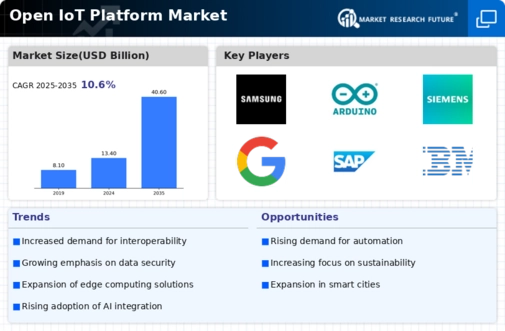Market Analysis
In-depth Analysis of Open IoT Platform Market Industry Landscape
The market dynamics of the Open IoT Platform market are shaped by a variety of factors, including technological advancements, consumer demand, regulatory frameworks, and competitive landscapes. Open IoT platforms have gained significant traction in recent years due to their ability to integrate diverse devices, protocols, and applications, offering flexibility and scalability to businesses across various industries. One of the key drivers of this market is the growing adoption of IoT solutions across sectors such as healthcare, manufacturing, retail, and smart cities. As organizations seek to leverage the power of interconnected devices to optimize operations, enhance efficiency, and deliver innovative services, the demand for open IoT platforms continues to rise.
Furthermore, the evolution of cloud computing technologies has played a pivotal role in shaping the market dynamics of open IoT platforms. Cloud-based IoT platforms offer advantages such as remote access, real-time data analytics, and cost-effective scalability, making them increasingly attractive to businesses of all sizes. With cloud services becoming more robust and affordable, organizations are more inclined to adopt open IoT platforms as they offer seamless integration with cloud environments, enabling them to leverage the full potential of IoT applications.
Moreover, the proliferation of connected devices and the Internet of Things ecosystem have contributed to the expansion of the open IoT platform market. As the number of connected devices continues to grow exponentially, there is a pressing need for platforms that can effectively manage and analyze the vast amounts of data generated by these devices. Open IoT platforms provide the infrastructure and tools necessary to collect, process, and derive insights from IoT data, empowering businesses to make informed decisions and unlock new revenue streams.
Additionally, the competitive landscape of the open IoT platform market is characterized by a diverse array of vendors, ranging from established technology giants to niche players and startups. This competition drives innovation and fosters continuous improvement in terms of platform features, functionality, and performance. Vendors are constantly striving to differentiate themselves by offering unique value propositions, such as support for specific industry verticals, interoperability with third-party systems, or advanced security capabilities.
However, along with opportunities, the open IoT platform market also faces several challenges and constraints. Chief among these is the issue of interoperability and standardization. As the IoT ecosystem continues to expand, there is a growing need for common standards and protocols that enable seamless communication and integration between different devices and platforms. Lack of standardization can lead to fragmentation and compatibility issues, hindering the widespread adoption of open IoT platforms.
Moreover, concerns around data privacy and security remain a significant barrier to the adoption of IoT technologies. With the proliferation of connected devices and the increasing volume of sensitive data being transmitted over IoT networks, organizations are under pressure to implement robust security measures to protect against cyber threats and data breaches. Open IoT platforms must address these concerns by incorporating robust security protocols, encryption mechanisms, and access controls to safeguard the integrity and confidentiality of IoT data.

















Leave a Comment